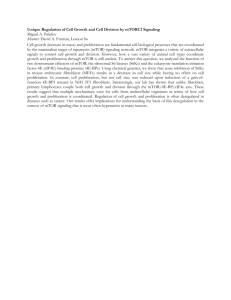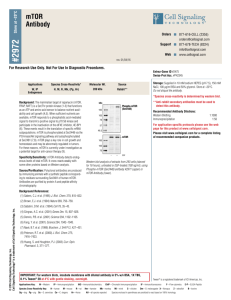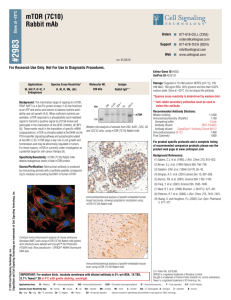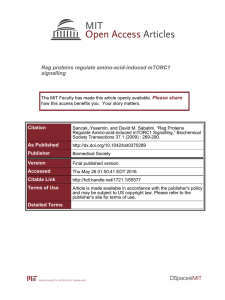P65 The acidosis-sensing amino acid transporter SNAT2 regulates t
advertisement
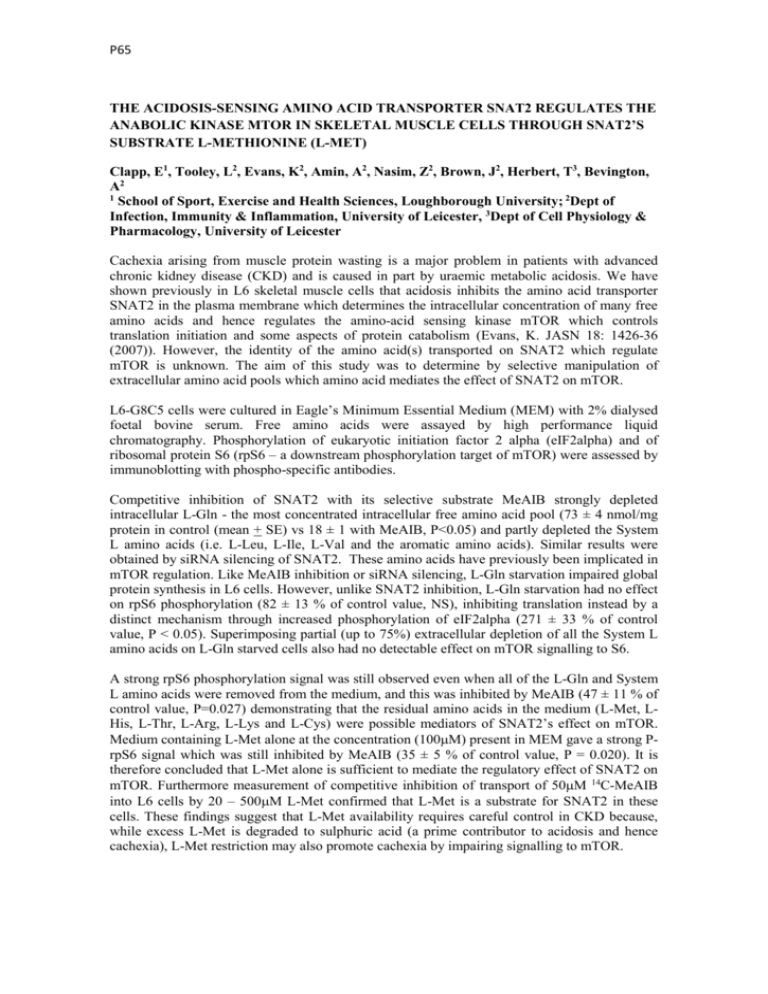
P65 THE ACIDOSIS-SENSING AMINO ACID TRANSPORTER SNAT2 REGULATES THE ANABOLIC KINASE MTOR IN SKELETAL MUSCLE CELLS THROUGH SNAT2’S SUBSTRATE L-METHIONINE (L-MET) Clapp, E1, Tooley, L2, Evans, K2, Amin, A2, Nasim, Z2, Brown, J2, Herbert, T3, Bevington, A2 1 School of Sport, Exercise and Health Sciences, Loughborough University; 2Dept of Infection, Immunity & Inflammation, University of Leicester, 3Dept of Cell Physiology & Pharmacology, University of Leicester Cachexia arising from muscle protein wasting is a major problem in patients with advanced chronic kidney disease (CKD) and is caused in part by uraemic metabolic acidosis. We have shown previously in L6 skeletal muscle cells that acidosis inhibits the amino acid transporter SNAT2 in the plasma membrane which determines the intracellular concentration of many free amino acids and hence regulates the amino-acid sensing kinase mTOR which controls translation initiation and some aspects of protein catabolism (Evans, K. JASN 18: 1426-36 (2007)). However, the identity of the amino acid(s) transported on SNAT2 which regulate mTOR is unknown. The aim of this study was to determine by selective manipulation of extracellular amino acid pools which amino acid mediates the effect of SNAT2 on mTOR. L6-G8C5 cells were cultured in Eagle’s Minimum Essential Medium (MEM) with 2% dialysed foetal bovine serum. Free amino acids were assayed by high performance liquid chromatography. Phosphorylation of eukaryotic initiation factor 2 alpha (eIF2alpha) and of ribosomal protein S6 (rpS6 – a downstream phosphorylation target of mTOR) were assessed by immunoblotting with phospho-specific antibodies. Competitive inhibition of SNAT2 with its selective substrate MeAIB strongly depleted intracellular L-Gln - the most concentrated intracellular free amino acid pool (73 ± 4 nmol/mg protein in control (mean + SE) vs 18 ± 1 with MeAIB, P<0.05) and partly depleted the System L amino acids (i.e. L-Leu, L-Ile, L-Val and the aromatic amino acids). Similar results were obtained by siRNA silencing of SNAT2. These amino acids have previously been implicated in mTOR regulation. Like MeAIB inhibition or siRNA silencing, L-Gln starvation impaired global protein synthesis in L6 cells. However, unlike SNAT2 inhibition, L-Gln starvation had no effect on rpS6 phosphorylation (82 ± 13 % of control value, NS), inhibiting translation instead by a distinct mechanism through increased phosphorylation of eIF2alpha (271 ± 33 % of control value, P < 0.05). Superimposing partial (up to 75%) extracellular depletion of all the System L amino acids on L-Gln starved cells also had no detectable effect on mTOR signalling to S6. A strong rpS6 phosphorylation signal was still observed even when all of the L-Gln and System L amino acids were removed from the medium, and this was inhibited by MeAIB (47 ± 11 % of control value, P=0.027) demonstrating that the residual amino acids in the medium (L-Met, LHis, L-Thr, L-Arg, L-Lys and L-Cys) were possible mediators of SNAT2’s effect on mTOR. Medium containing L-Met alone at the concentration (100M) present in MEM gave a strong PrpS6 signal which was still inhibited by MeAIB (35 ± 5 % of control value, P = 0.020). It is therefore concluded that L-Met alone is sufficient to mediate the regulatory effect of SNAT2 on mTOR. Furthermore measurement of competitive inhibition of transport of 50M 14C-MeAIB into L6 cells by 20 – 500M L-Met confirmed that L-Met is a substrate for SNAT2 in these cells. These findings suggest that L-Met availability requires careful control in CKD because, while excess L-Met is degraded to sulphuric acid (a prime contributor to acidosis and hence cachexia), L-Met restriction may also promote cachexia by impairing signalling to mTOR.








